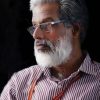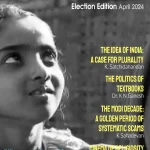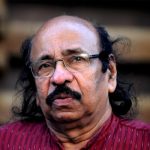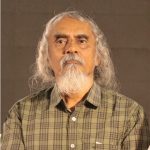

P. K. Surendran
“Each age will read, interpret, and make their own Ramayana and Mahabharata”
Myths and rituals are used by one group for religiously motivated political interests, while another group rejects them by associating them with religion and superstition. When myths and rituals are presented in art, it is viewed as religious revivalism by certain critics. Filmmaker Ashish Avikunthak makes his films against such a backdrop. The sources of his films are Hinduism and ancient Indian philosophy, aesthetic thought, mythology and history. He uses Hindu rituals a lot in his films. These films are creative defences and criticism from within religion rather than from outside. By doing this, they are opening up possibilities against communalism and racism. Avikunthak is projecting creative expressions by relating the diversity of religion to the contemporary situation where it is being homogenized. Also, an anthropologist, Avikunthak’s endeavors are cultural excavations through the medium of cinema. While it is a journey into the past, it is not a revivalist effort. He tries to free the concept of ‘Hindu’ from so-called Hinduism.
But Avikunthak presents all these not like mainstream cinema or the style of our ‘art’ and ‘political’ films. Although some of our films present ‘progressive’ ideas in their content, they follow a conservative style in form. Avikunthak uses a less familiar form. The movie ‘Apotkaalin Trikalika’ is shot in grainy home-cinema style with stark monochrome and color. Long and short takes and slow and long paces define its narration. ‘Kalkimanthan Katha’ is shot in greyish black and white and dusty colors. The film gives the feeling of falling snow. In the movie ‘Nirakar Chaya’, vivid colors, black and white, and monochrome are used a lot. Their use implies a structural game of cinematic texture. In this way, his films create a visual, sensory, and tactile experience that transcends the eyes and ears by using the alchemical and structural nature of the images.

Avikunthak’s films are the most experimental in Indian cinema. As Neru Ratnam writes, “Avikunthak’s films are rooted in Indian religion, philosophy and history, without being about any of these in an anthropological way. Avikunthak’s works strongly resist being so easily packaged for the new global artworld circuits”. Though we may find similarities with the art house/avant-garde films of the 70s and 80s, these films depart from them. The international publication Art Review wrote on Avikunthak’s films: “These are self-consciously difficult works that are filmed in a self-consciously beautiful way.”
Avikunthak works as an associate professor in the film department of the University of Rhode Island, USA. He holds a Ph.D. in Cultural and Social Anthropology from Stanford University. He has directed short films Et Cetera, Kalighat Fetish, Rummaging for Pasts, Performing Death, Dancing Othello, End Note, Vakrathunda Swaha, as well as feature films Nirakar Chhaya, Katho Upanishad, Rathi Chakravyuh, Kalkimanthan Katha, Aapothkalin Trikalika, Vrindavani Vairagya and Devastated. (The movie Nirakar Chhaya is based on Sethu’s novel ‘Pandavapuram’.).
Midnight raids, encounter killings, laws like U.A.P.A., indefinite imprisonment without trial, surveillance, and arrests are carried out at will these days. An undeclared state of emergency exists in today’s India. What would happen if our gods and goddesses were to incarnate on earth in this bleak socio-political situation? How will they react to the violent events in the contemporary world? If they walk on the earth like men and women, how can they reconcile with our chaotic modernity? Avikunthak’s film ‘Aapaat Kalin Trikalika’ presents profound thoughts on the undeclared emergency through Kali and Kali’s avatars incarnated in such a world order.
Avikunthak talks about his films in the context of religious revival efforts in India.
Question: The Bhagwat Gita says, “For the protection of the good and to annihilate the miscreants, as well as for the establishment of dharma, I appear, age after age.” I don’t know whether you are influenced by these words while thinking about ‘Aapothkalin Trikalika’.
Answer: Interestingly, you invoke Gita in the context of Aapothkalin Trikalika. It was considered by most Indian sectarian practitioners as a marginal text and was not a popular text in ancient India. For instance, throughout the last millennium, there have been less than a dozen commentaries, as compared to more than a hundred translations and commentaries in the last century! The Bhagwat Gita, as a singular text that exemplified Hinduism, only gained prominence with the rise of Indian nationalism during the Independence movement. By the early 20th century, it had metamorphosed into the metatext of modern Hindu revivalism. Scholars have argued, and I would say conclusively, that its popularity in contemporary Hinduism was propelled by the English translation of the book in 1785. The colonial authority legitimized the validity of the Bhagwat Gita as the particular text of Hindu theology, as it was an apparent mimesis of their own Christian Bible. This was the time of Warren Hastings when there was an anxious quest by colonial occupants for a conclusive epistemological universe to govern the newly subjugated people. It was during his time that Manusmriti emerged as the conclusive juridical text, whereas the Bhagwat Gita emerged as the spiritual textbook. It is important to underscore that Bengal in the 18th century was largely a tantric world, and texts like the Gita and Upanishads were largely the preoccupation of the Brahmanical elite, who were the religious and cultural informants of the new rulers. With the rise of the Indian independence movement, Bhagwat Gita was appropriated by all sections of the nationalists, from Gandhi and Tilak to right-wing ideologues.

Question: Will you elaborate on this aspect?
Answer: I am saying that its supposedly primordial prominence as an essential book of Hinduism is the product of colonial modernity. Bhagwat Gita was a marginal text that was principal to a particular sect of elite Hindus (Bengali Vaishnava Brahmins) who had gained access to colonial governmentality. Subsequently, it was catapulted into prominence by early modern nationalists, who, as Partha Chatterjee has prudently shown, were a product of a derivative Western discourse. Bhagwat Gita snuggly nestles into this imagination as it provides a singular discursive key to a highly complex and variegated universe. This is exacerbated by the highly succinct semantics of this book, which allows alarmingly variant interpretations. For instance, this book was called the Bible both by the pacifist Gandhi and the Nazi fascist Heinrich Himmler. Himmler, who was the orchestrator and creator of the Holocaust, used the logic in the Bhagwat Gita to justify the annihilation of Jews. The Bhagwat Gita is a text that is not merely a Hindu text. It is specifically a book that is central to Vaishnava theology. It is a text that attempts to synthesize the varying strands of Hinduism but from a primarily Vaishnava perspective. Aapothkalin Trikalika is not influenced by this text in any sense. On the other hand, Aapothkalin Trikalika is firmly located in a Tantric ontology.
Question: In India, a revival process is taking place in the field of religion. Even in Kerala, a state that is known for its ‘progressiveness’, a lot of new temples are constructed. In the same way, several ruined temples are revived. There are a lot of temples for local gods and goddesses in Kerala. Here, puja is not performed by Brahmins. During the festivals, low-caste people transform into God and perform in front of the people. This is called Theyyam (God). These low-caste people are otherwise not treated equally to higher-caste people in real life. This is purely Dravidian in its character. But now there is a tendency to connect these local gods with Sanskrit and Brahmanism. In this way, they are trying to erase indigenous culture.
Answer: Religion is a dynamic cultural process. It is always in motion. In the case of what we call Hinduism, the process of iteration, erasure, reappearance, reinvention, reconfiguration, and invagination is a perpetual part of its identity. Hinduism is a misnomer. It is not a singular religion or thought; it is a conglomeration of ideas, practices, cultures, and concepts, often in conflict with each other. Colonial Indologists, subsequently nationalist historians, and now fundamentalist historians have often painted a picture of a static, unchanging, primordial Hinduism. They have underscored the divergence and variegation but have attempted to encapsulate them in a larger armature. This is far from true. Hinduism is a religion often in conflict within its constituencies. The example that you have given in Kerala is not unusual. This revival, reappearance, and reconfiguration are central to its theological ontology. With the rise of modernity, especially its modes of representation—print (newspapers, journals, calendar art), cinema (early Indian cinema was deeply religious), television (religious serials, tele-preaching in the style of Ramdev Baba and Asaram Baba), and now social media, the social, cultural, and moral ontology of modern Hinduism has been dynamically churning. The character of what we think of as an ancient, primeval, and primordial religion is deeply modern. Pre-modern Hinduism was a composite of sectarian practices highly localized and compartmentalized within its own geographic and linguistic niches. Contemporary modern Hinduism is moving towards political and cultural homogeneity, best exemplified by Hindutva ideology. This political-religious movement is gradually strangling the heterogeneity of sectarian Hinduism. So, it is no surprise that gods and goddesses of the non-Brahmanical are seeing a powerful resurgence not just in Kerala but also in Bengal and other parts. This has to be understood as a simmering conflict within modern Hinduism. So, there is nothing indigenous in a primordial sense; it’s a process of constant churning and reorganization. The erasure that you talk about is also a construction. And this creation is also a form of expurgation. It is not just the new demolishing the old; it is also, peculiarly, the old restructuring the new. Hindutva is the former, where the new is virulently demolishing the old and, in the process, conducting what is essentially an act of modernity.
Question: Another interesting aspect is that the dialogues are genderless. Males talk the dialogues supposed to be talked by females, and vice versa.
Answer: This was a deliberate choice. “Rati Chakravyuh” is a post-national and post-gender film. I wanted to break distinct subjectivity—both that of an individual and that of gender. I wanted to celebrate the idea of a communitarian consciousness. Here, the dialogical conversation was a form through which a uniform cognizance of post-national, post-gender India is explored, which is beyond the dichotomy of gender and the schism of individuality. This is the politics of this film. We live in a time when gender boundaries are slowly obliterating along with national boundaries. However, this natural obliteration is causing rebuttal violence, either in the form of excessive violence against women (in the case of post-gender) or the powerful growth of the Hindutva (in the case of post-national). Both of these are symptoms of the collapse of nationalism and gender subjectivity. In this film, I am gesturing towards these two core ideas of my ideological persuasion. As a product of a partition-affected family, I have a profound disdain for the idea of the nation-state; therefore, I espouse a post-national world. Similarly, I believe gender distinctions are the root cause of individual disharmony.
Post-gender refers to the idea of eliminating or moving beyond gendered identities. It argues that one is neither a man nor a woman, nor is there any other assumed gender role. An individual in society is not reduced to a gender role but is simply an agent of humanity who is to be defined by one’s actions. Key figures associated with this theory are radical feminists like Shulamith Firestone and Dona Haraway.
Post-national refers to the breaking down of national boundaries with the rise of global capital, the Internet, and international human rights laws. Here, the move is from the idea of citizenship associated with one particular country to the idea of personhood with universal rights. The key figure associated with this theory is SaskiaSassen.
Question: Your portrayal of epic characters and incidents is at its extreme. It subverts the conventional understanding of cinematic narrative. Will you elaborate?
Answer: For me, mythologies, especially Indian mythologies, are living traditions. They are not static texts that exist in the Western world. They are living traditions. Epics such as the Ramayana, Mahabharata, and Puranas were never held as static texts. They were always in motion, constantly changing and transforming in a continuous process of metamorphosis. These were living texts. These were oral, ontological traditions rather than an orthodox written tradition. Ideas, thoughts, words, and stories were always in flux. They were in an endless process of evolution and alteration. Neither were these singular texts as seen in the Greek or Roman traditions. These had multiple lives, many origins, and many forms. For instance, the critical edition of the Mahabharata that has been published by the Bhandarkar Oriental Institute in Pune was produced from 1,259 manuscripts. In the case of the Ramayana, A. K. Ramanujan’s famous essay, “Three Hundred Ramayanas: Five Examples and Three Thoughts on Translation,” which was removed from the history curriculum of Delhi University by Hindutva forces a few years ago, elegantly argues for the multiplicity and diversity of the Ramayana tradition. It is the hegemonic essentiality of modernity, with its fixation with a written, closed, one, unchanging artifact—the book—that certain permanency is desired. Indian tradition has always resisted this idea because of the intense amount of diversity and multiplicity that has existed in India. Aravindan’s masterpiece ‘Kanchana Sita’ and my film ‘Rati Chakravyuh’ are part of this long practice of retelling, reinterpreting, and reconfiguring religiosity. The brilliance of these texts is that they have a substantial space for contemporary interpenetrative spheres to interact with them. Each age will read, interpret, and make their own Ramayana and Mahabharata.
One plane of Avikunthak’s new film ‘Devastated’ is a series of conversations between a middle-aged police encounter expert and his wife and girlfriend(?) in contemporary India. The woman blames him and questions his actions. She says that the stench of raw flesh and blood emanates from his body—breath, chest, armpits, back, testicles, anus—almost everywhere. But he justifies his actions, like Krishna. He has the appropriate antidote to justify it: every time he fires a shot, he chants a cardinal incantation. As a result, he and his bullet escape the consequences of their actions. He doesn’t see his ‘self’ as a killer. He is just one of the martyrs who serve the motherland. Parallel to this, there is another plane of Krishna-Arjuna dialogue in which Arjuna, who is too exhausted to face his condition of having to kill his relatives and gurus on the front of the war, is admonished by the Geethopadesa to become active in his karma. The main character and another person at several places quote lines from the Gita in the context of war in a dispassionate manner. Avikunthak says about the film: “The violence of the encounter specialist also emerges from a deep-seated desire for social and national normativity. Psychologically, extrajudicial killing in India emerges from a patriarchal nation that desires to execute its citizens, who are not submissive, normative, or obedient. Why does a democratic nation like India have to resort to such drastic means to obliterate its citizenry? There are very few democratic countries in the world that have taken recourse to such extreme measures.”
P. K. Surendran : After his long service at the Center for Monitoring Indian Economy in Mumbai, P K Surendran is now settled in Taliparamba in Kannur district. He writes articles on cinema in leading Malayalam publications and delivers lectures on cinema on Akashvani. He has presented papers on cinema in various seminars. He also takes classes on film in colleges as a guest.
His work ‘Akhyanathinte Piriyan Kovanikal’ won the State Government Award for best book on cinema.























